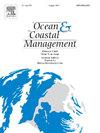Influence of coastal forest width and stand density on tsunami mitigation in coastal forest management
IF 5.4
2区 环境科学与生态学
Q1 OCEANOGRAPHY
引用次数: 0
Abstract
The concentration of population along coastlines increases vulnerability to climate change-related natural disasters, such as storm surges, wind damage, and tsunamis. Coastal forests, as infrastructure, play a crucial role in mitigating these risks. In tsunami-prone countries like Japan, coastal forests are particularly valuable. Coastal forests mitigate disasters during tsunamis and storm surges by reducing fluid force and trapping drifts; previous studies on tsunamis have confirmed the protective effects. However, since forests change their complex structure as they grow, the effects of tsunami mitigation also continue to change. To comprehensively understand the impact of forests on tsunamis and establish effective forest management methods, it is necessary to clarify the tsunami mitigation effect of forests according to their growth phases. This study conducted numerical simulations to investigate the effects of forest width and stand density on tsunami mitigation in nine coastal Japanese black pine forest patterns at different growth phases. Forest widths were set to 100, 200, and 300 m. Stand density was quantified using the relative yield index (Ry) and classified into high, medium, and low stand density, respectively. The results showed that increased stand density or forest width reduces fluid force. The tree destruction mode depended solely on forest management, which was linked to stand density. Furthermore, management patterns with medium or low stand density are preferable to avoid secondary damage from stem breakage caused by huge tsunamis. These results provide valuable insights into coastal forest management.
海岸带森林宽度和林分密度对海岸带森林管理中海啸减灾的影响
沿海人口的集中增加了对与气候变化有关的自然灾害的脆弱性,如风暴潮、风灾和海啸。沿海森林作为基础设施,在减轻这些风险方面发挥着至关重要的作用。在像日本这样的海啸易发国家,沿海森林尤为宝贵。沿海森林通过减少流体作用力和截留漂流物,减轻海啸和风暴潮期间的灾害;以前对海啸的研究已经证实了它的保护作用。然而,由于森林在生长过程中改变了其复杂的结构,因此减轻海啸的效果也在继续变化。为了全面了解森林对海啸的影响,建立有效的森林管理方法,有必要按生长阶段明确森林的海啸减灾作用。本文通过数值模拟研究了9种沿海黑松林不同生长期林分宽度和林分密度对海啸减灾的影响。森林宽度设置为100米、200米和300米。利用相对产量指数(Ry)对林分密度进行量化,并将其分为高、中、低林分密度。结果表明,林分密度和林宽的增加均可降低流体力。树木破坏模式完全依赖于森林经营,与林分密度有关。此外,为了避免大海啸造成的茎杆断裂造成的二次破坏,宜采用中低林分密度的管理模式。这些结果为沿海森林管理提供了宝贵的见解。
本文章由计算机程序翻译,如有差异,请以英文原文为准。
求助全文
约1分钟内获得全文
求助全文
来源期刊

Ocean & Coastal Management
环境科学-海洋学
CiteScore
8.50
自引率
15.20%
发文量
321
审稿时长
60 days
期刊介绍:
Ocean & Coastal Management is the leading international journal dedicated to the study of all aspects of ocean and coastal management from the global to local levels.
We publish rigorously peer-reviewed manuscripts from all disciplines, and inter-/trans-disciplinary and co-designed research, but all submissions must make clear the relevance to management and/or governance issues relevant to the sustainable development and conservation of oceans and coasts.
Comparative studies (from sub-national to trans-national cases, and other management / policy arenas) are encouraged, as are studies that critically assess current management practices and governance approaches. Submissions involving robust analysis, development of theory, and improvement of management practice are especially welcome.
 求助内容:
求助内容: 应助结果提醒方式:
应助结果提醒方式:


